No doubt you have probably heard about Michelle Obama’s new program, “Let’s Move” which is designed to draw attention to obesity problems with children and how it is our  responsibility to dive in here, as we are creating some of the methodologies that are leading to this problem as adults. As Mrs. Obama has pointed out, it’s not the kids who are creating junk foods, we are. As the old saying goes if you are not part of the solution, then you are part of the problem, thus her call to bring a worldwide awareness and focus to the problem. It’s not like a disease where we are still searching for an answer. We have answers and it’s time to act upon them.
responsibility to dive in here, as we are creating some of the methodologies that are leading to this problem as adults. As Mrs. Obama has pointed out, it’s not the kids who are creating junk foods, we are. As the old saying goes if you are not part of the solution, then you are part of the problem, thus her call to bring a worldwide awareness and focus to the problem. It’s not like a disease where we are still searching for an answer. We have answers and it’s time to act upon them.
Today I had the chance to speak with Dr. Patricia Richards, a pediatrician at Kaiser Permanente in Maryland, who was kind of enough to enlighten me on some of what is working for her as a doctor, and much of what she recommends has already been incorporated into how she practices medicine for quite a while. To enhance the process, Dr. Richards stated that by using electronic medical records is a huge asset in working both with the children and their parents. By using electronic records, it allows her to stay “on course”. Healthcare facilities everywhere are a busy place today and it is so easy to become distracted, by a phone call, a staff member asking a question, etc. while conversing with a child’s parents. Does this sound familiar; of course it does as it happens to all of us.
I asked her about how she felt the records on the computer help her in her day to day routine of working with patients. Dr. Richards said she could not imagine  having to use a paper chart as all the information she needs is right in front of her with electronic records. In addition to using the standard weight and height figures and BMI (body mass index) calculations, she relies heavily upon “growth charts” to display a picture for the parents. She stated printing a copy of their child’s growth chart and handing it to them gives the parents a much easier format to understand, a visual. She said that it’s standard procedure for her to provide a copy of the growth chart to parents with every visit. We discussed how important basic vital information is in the chart with high visibility, in other words where you can’t miss it, so the BMI and other vitals are staring the doctors in the face and this helps ensure that all areas are addressed and discussed.
having to use a paper chart as all the information she needs is right in front of her with electronic records. In addition to using the standard weight and height figures and BMI (body mass index) calculations, she relies heavily upon “growth charts” to display a picture for the parents. She stated printing a copy of their child’s growth chart and handing it to them gives the parents a much easier format to understand, a visual. She said that it’s standard procedure for her to provide a copy of the growth chart to parents with every visit. We discussed how important basic vital information is in the chart with high visibility, in other words where you can’t miss it, so the BMI and other vitals are staring the doctors in the face and this helps ensure that all areas are addressed and discussed.
If you are a parent and have had visits with a pediatrician you are probably aware of how a child’s growth is tracked via the Centers for Disease Control and Prevention’s growth charts and perhaps have some of your own supplied by a pediatrician. Dr. Richards stated with the use of the formatting with the Kaiser Permanente medical records, the information is automatically charted and has additional items to add information beyond the dots. The charts are coded with a blue line and a red line. This makes it easy at a glance to immediately track the history and show the parents where the lines need to be relative to both height and weight.
The charts do a very good job at mapping BMI at a glance too. BMI is a tool that has been around for a long time but its value perhaps has been underestimated and maybe underused in the last few years as a whole. If you want to see how this if figured, the Centers for Disease Control and Prevention (CDC) has an online calculator, for children up to 19 years of age, and there’s also a link to one for adults. The above image of a growth chart is from the CDC website.
Dr. Richards stated that involving the parents also works with the idea of “taking ownership” as a parent. She further states that giving handouts to patients and 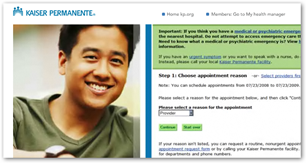 in addition to the charts has proven to be highly successful. In other words in an office visit there is only so much she can cover, but when additional educational material is used in conjunction with a visit, you get many more miles added to the effort.
in addition to the charts has proven to be highly successful. In other words in an office visit there is only so much she can cover, but when additional educational material is used in conjunction with a visit, you get many more miles added to the effort.
At age 6 Dr. Richards begins tracking BMI with patients. She said if there were a problem with a younger child needing help in this area under this age, it certainly is addressed as well. One of her secrets that she shared with me is about explaining to both parents and children is the difference between “treats” and “snacks”. I never had given much thought myself to distinguish a difference but it made sense to me as an adult too.
Treat = Candy, Ice Cream, etc.
Snack = Vegetables, fruit, crackers, etc.
In other words snacks should be healthy foods, and treats are the items that could become villains if their consumption overrides what should be considered a balanced diet and sensible eating habits.
OK so now we have covered some of the basics here so I went a little further here to inquire about how the medical records work with parent and patient access. How’s 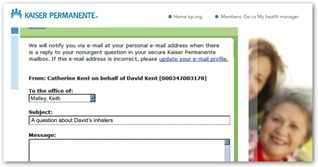 it’s all handled today as we have some very advanced kids with technology and computer skills. Can they use and access their medical records to enhance their own participation without requiring printed paper hands outs with each visit? In other words how does the PHR (personal health records) from Kaiser come into play? Is this part of the overall plan of action too?
it’s all handled today as we have some very advanced kids with technology and computer skills. Can they use and access their medical records to enhance their own participation without requiring printed paper hands outs with each visit? In other words how does the PHR (personal health records) from Kaiser come into play? Is this part of the overall plan of action too?
Oh yes, Dr. Richards stated, “we have some successful methods” that further enhance the process with patients being able to access their information online via kp.org. With (KP.org) Kaiser Permanente's PHR (personal health records) parents can go online at any time and review the information in their child’s chart. For that matter they can also take a moment to review their own too while they are logged on I commented.
The parents can log on any time they want to review and read up. Dr. Richards says this has become a real valuable tool as individuals have the choice to work it into their schedule when they have the time, after work, on weekends or any other time they desire access as it is available 24/7. I went on to ask Dr. Richards a couple other questions in this area. At what age can the child begin seeing their information and logging on, in other words how long is this information only for the eyes of “Mom and Dad”?
She said that this is a very good question and told me that at age 13 the child moves out from being completely underneath the parents only and at this point they get their own log on established to view and interact with their medical records. Parents of course still have access to the chart information as well.
I thought this was very smart as by 13 some children are way above the 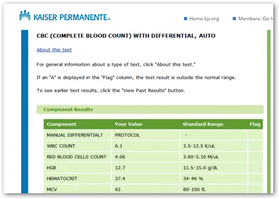 computer level knowledge of some parents so let them go for it and get involved and start the grooming process for taking ownership of their health issues and lifestyles as this is something that carries through on to adulthood.
computer level knowledge of some parents so let them go for it and get involved and start the grooming process for taking ownership of their health issues and lifestyles as this is something that carries through on to adulthood.
Dr. Richards cited one other big advantage with the use of electronic medical records and that is her ability to communicate with patients via the PHR (personal health record). She could, from her end of managing her patient care decide to “red flag” some files that she feels needs some additional interactions or just follow up.
Patients and parents also have an avenue to communicate with Dr. Richards in between visits via secure email. This enables her to send some friendly reminders here and there and to perhaps advise of some new material to read and study as relates to obesity or any other issues where she is consulting for the patient. I asked her if she uses email with her patients and she said “all the time” and again she sees this as an asset to help build the doctor'/patient relationship too.
Dr. Richards states that some of her best methods of getting patients and parents involved is to suggest small changes in lifestyle, and these represent small goals that can easily be adapted, maybe one at a time so the changes do not appear so overwhelming and work easily with day to day life. With smaller children she also uses a small reward program for meeting goals, in other words giving some recognition, and we all like that even as adults.
In summary, Dr. Richards confirms that better healthcare is achieved through the use of electronic medical records and with the focus on helping children in the area of BMI and weight management, sees the electronic medical records system KP.org, that she and the patients use at Kaiser Permanente as being one critical and important part of the solution.
I want to thank Dr. Richards for taking time out today and sharing some valuable information. I agree with her assessment here as if you are trying to do all of this with old paper methodologies today, there’s no way to keep up.


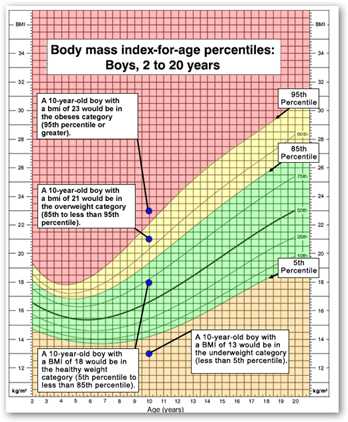

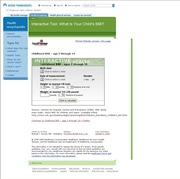


0 comments :
Post a Comment